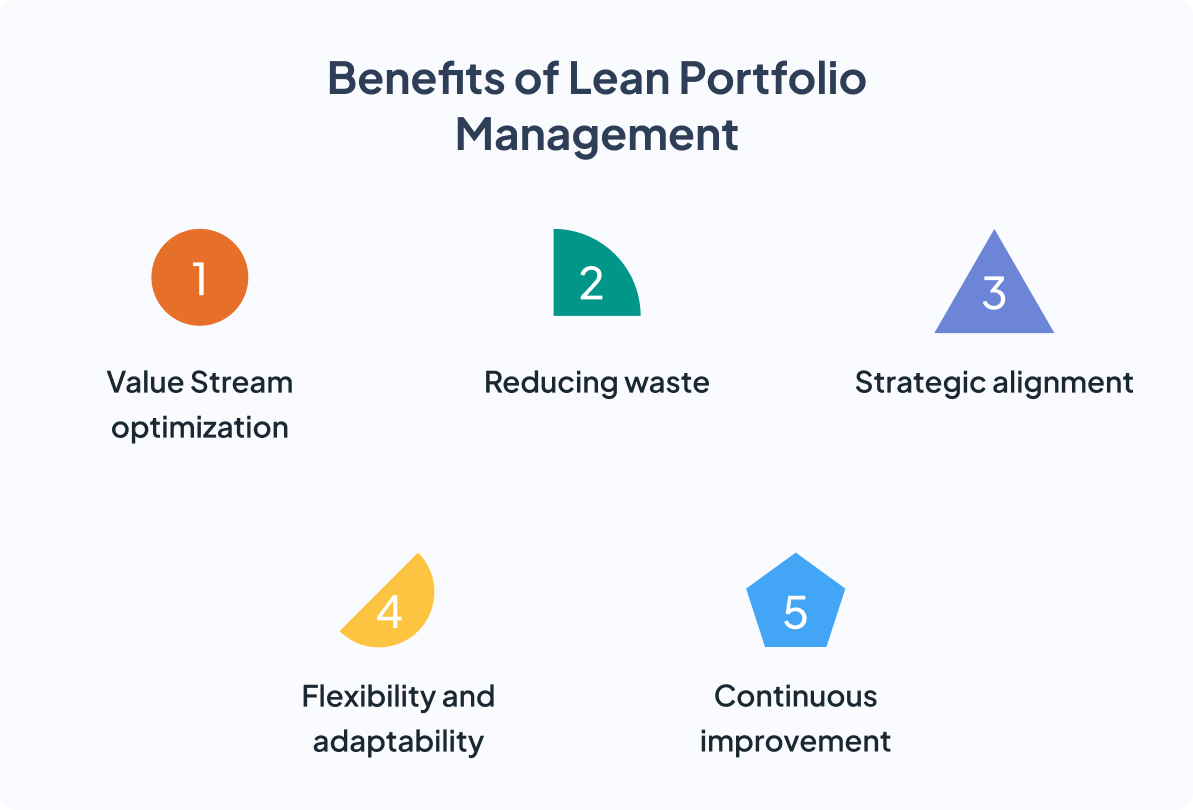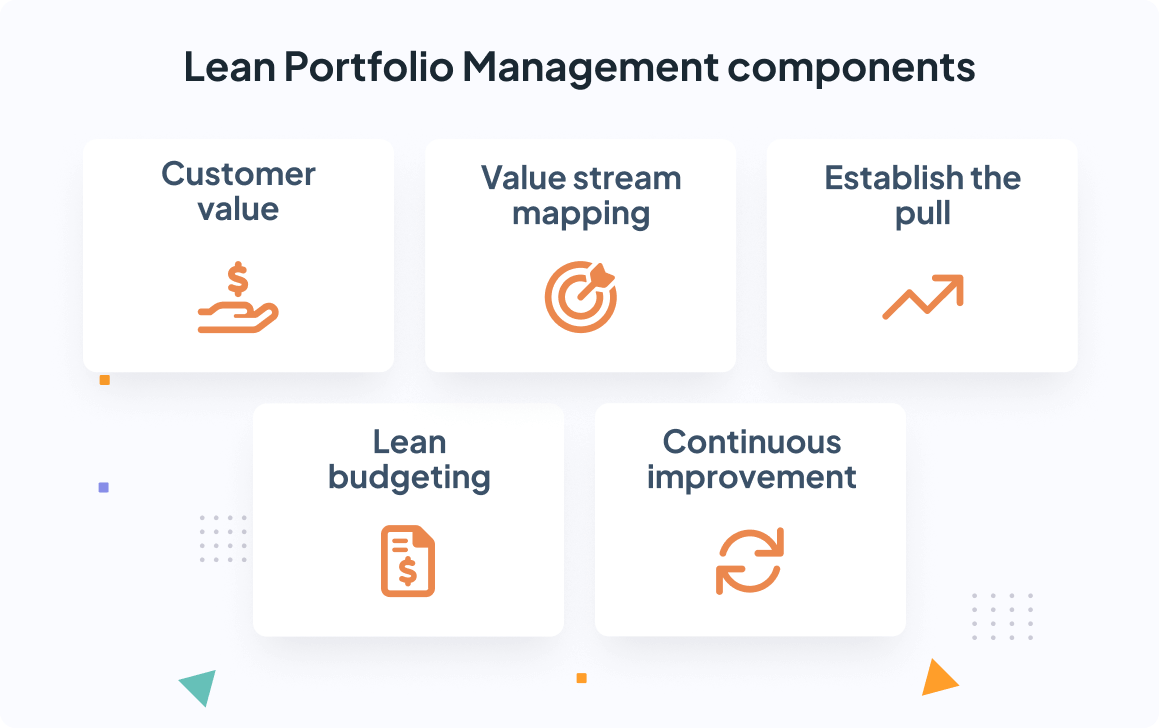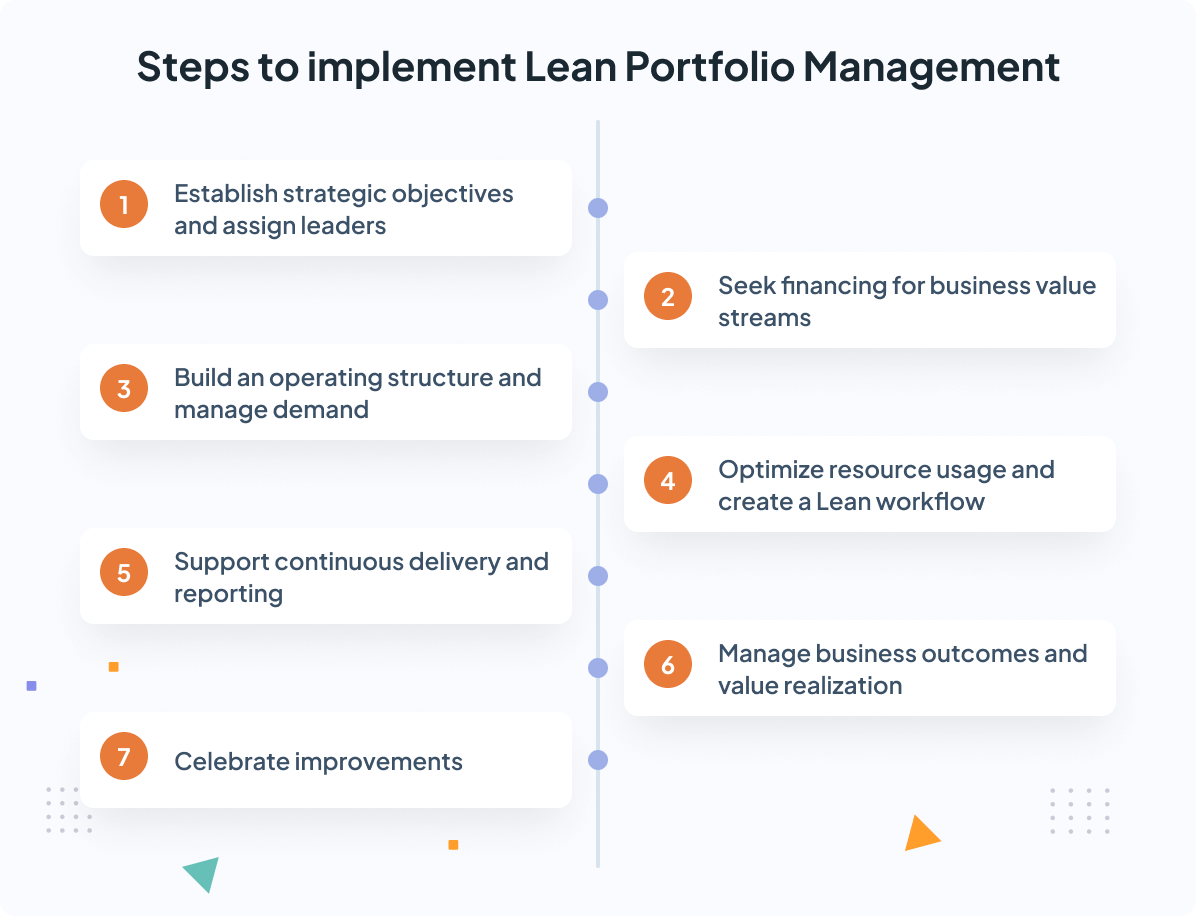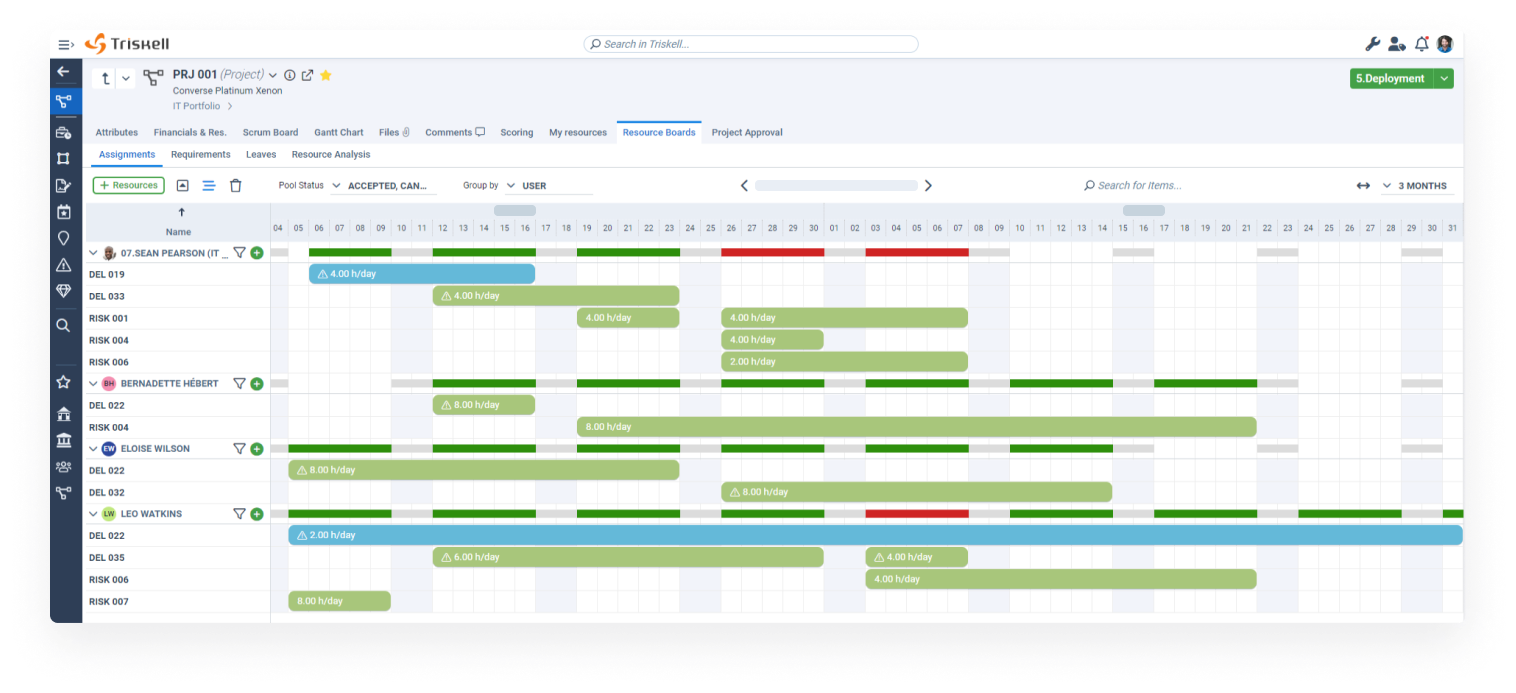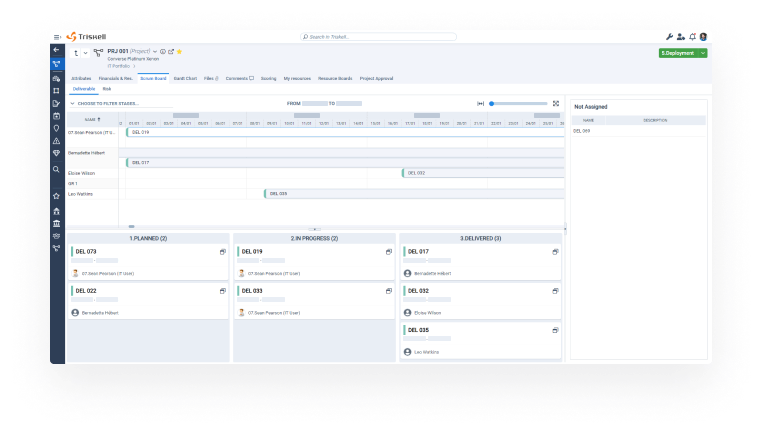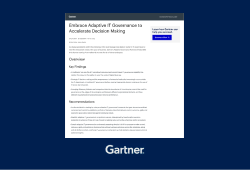A comprehensive guide to Lean Portfolio Management: your path to achieve business agility

Lean Portfolio Management is an Agile methodology that focuses on optimizing the delivery of value through efficient management of the organization’s product and service portfolios, ensuring their alignment with strategic objectives. And, in today’s dynamic and competitive business environment, it’s proving to be an effective solution for maximizing organizational agility in successfully responding to market changes.
In this guide, you’ll discover how Lean Portfolio Management can transform the way your organization manages its portfolios and value streams, and how PPM software can help streamline the implementation of this new approach.
What is Lean Portfolio Management
Lean Portfolio Management is a strategic approach that enables organizations to align their investments with strategic objectives, maximizing business value and optimizing available resources. It is based on Agile principles to manage workflow and value delivery efficiently, adapting to market changes and minimizing waste.
Furthermore, Lean Portfolio Management not only focuses on managing individual projects but encompasses a holistic view of an organization’s product, program, and project portfolios. With this approach, you can identify, prioritize, and execute initiatives that have a significant impact on the business while aligning them with the overall business strategy.
Lean Portfolio Management is based on Agile principles to manage value streams efficiently
Why Lean management? Types of Portfolio Management
And what does Lean have compared to other approaches to Project Portfolio Management? PPM is a discipline that has been constantly evolving for the past 20 years. So much so that, over this time, many terms have emerged around the concept of ‘portfolio management,’ which, while having many similarities, have certain nuances that set them apart.
- Business portfolios: it focuses on the strategic management of all projects, programs, and products within an organization to align them with business objectives and maximize overall business value.
- Project portfolios: it concentrates on the selection, prioritization, and execution of individual projects to ensure they contribute to the organization’s strategic objectives and generate value effectively.
- Product portfolios: it handles the management of all products and services offered by the company, ensuring they are aligned with customer needs and organizational objectives.
- IT project portfolios: it focuses on managing projects related to information technologies. Its goal is to ensure that IT projects support business objectives and make the most of available technological resources.
And, following all these management approaches, we have Lean Portfolio Management. Its main differentiating element lies in offering an agile and adaptable framework that aligns with Lean principles, enabling organizations to:
- Optimize continuous value delivery.
- Reduce time to market.
- Respond quickly and effectively to unforeseen changes in markets.
WHITE PAPER
Implementing Agile for Enterprise Adoption
Benefits of Lean Portfolio Management
Therefore, the Lean Management approach establishes a solid foundation upon which companies can eliminate waste, improve efficiency, and maximize return on investment in their portfolios of projects, programs, and products.
But these are not the only benefits of Lean Portfolio Management. Below, we list all the advantages that this approach provides to those organizations seeking to enhance their efficiency and business agility:
- Optimization of value streams by prioritizing projects that will generate the greatest value for the customer and the company, ensuring efficient allocation of resources and swift, continuous delivery.
- Waste reduction by eliminating activities that do not add value, thereby minimizing resource waste and increasing productivity.
- Enhanced strategic alignment: Applying a Lean approach to your project portfolios will ensure they are aligned with the organization’s strategic objectives, thereby improving the effectiveness and impact of business initiatives.
- Flexibility and adaptability: your organization will gain agility to quickly adapt to market changes and customer needs to remain competitive at all times.
- Continuous improvement: Lean Portfolio Management inherently fosters a culture of continuous improvement, where areas for improvement are constantly identified and addressed to optimize processes and maximize business results.
Key elements of Lean Portfolio Management
Now that you have an understanding of what Lean Portfolio Management is, let’s focus on listing its essential elements for proper implementation and to maximize organizational benefits.
These are the essential components of Lean Portfolio Management:
Value to customers
Lean management is characterized by its focus on continuously delivering value to customers. This entails a detailed understanding of customers’ needs and expectations, as well as the ability to prioritize and adapt portfolios and business initiatives to meet those constantly evolving demands.
By focusing on generating value for customers, organizations will not only have more satisfied customers but also a sustainable competitive advantage over time.
Mapping the value streams
Another crucial element is the detailed mapping of value streams throughout the supply chain and the organization. This process involves visualizing and understanding how value is created and delivered to customers through various business processes and activities.
By mapping value streams, organizations can identify and eliminate activities that do not add value, thus reducing bureaucracy, waste, and maximizing the efficiency of their operations for quicker and more profitable delivery of products and services.
Learn how to boost Enterprise Agility with Triskell
Request a personal demo to get a clear view of how you can better plan, pivot, and deliver customer value with Triskell.
Establishing Pull
Establishing ‘pull’ refers to organizations’ ability to respond quickly and efficiently to customer demands and needs. Instead of pushing products and services into the market based on internal assumptions, Lean Portfolio Management adopts a customer-centric approach, where customer demand drives production and value delivery.
This allows organizations to minimize excess inventory and maximize operational efficiency by producing only what is needed when it is needed.
Customer demand is what drives manufacturing and value delivery
Lean budgeting
When it comes to implementing Agile in all portfolio management processes, many organizations realize that traditional project-based accounting poses numerous issues. For example:
- Sluggish budgeting processes.
- Imprecise decision-making.
- Delays in delivery timelines.
Frameworks like Lean Portfolio Management and SAFe replace this project-based cost accounting model with a different type of financing based on overall value streams. This helps improve financial control and reduce overhead costs and friction, enabling greater development performance.
Pursuing excellence
In Lean Portfolio Management, the pursuit of excellence is the principle driving continuous improvement in all management and governance processes. It’s a principle that involves not settling for the status quo but constantly seeking ways to optimize and enhance efficiency, quality, and value delivery.
Moreover, with a mindset of continuous improvement, organizations can stay agile and adapt quickly to market changes, thus maintaining their long-term competitive advantage.
How to implement Lean Portfolio Management
Now that you understand the foundations on which Lean Portfolio Management is based, you should know that implementing it is not something achieved overnight. Instead, it requires that you follow a series of steps for success.
These are the steps you should follow to implement Lean portfolio management in your organization satisfactorily:
Establish strategic objectives and assign leaders
The first step is to establish clear strategic objectives. These objectives should be closely aligned with the organization’s mission and vision and should be SMART (specific, measurable, achievable, relevant, and time-bound).
Simultaneously, the organization should appoint leaders to oversee the execution of this strategy. These leaders should be responsible and competent to ensure effective leadership and proper monitoring of progress toward achieving the objectives.
Find funding for business’ value streams
Next, it’s necessary to seek and allocate the appropriate funds to the business value streams, supporting the previously established strategic objectives. It’s a highly complex process that involves, on one hand, identifying key areas requiring investment, and on the other hand, seeking appropriate sources of funding (equity, external investors, bank loans, etc.).
Throughout this process, it’s crucial to evaluate all available financing options and then select those that best align with the needs and objectives of the business.
Build an operating structure and manage demand
Once the objectives and funds for each value stream are defined, it’s necessary to build an efficient operational structure to manage demand effectively. This involves designing an organizational framework where roles, responsibilities, decision-making processes, authority delegation, and risk management are clearly defined to:
- Promote transparency and accountability at all levels of the organization.
- Ensure alignment and collaboration among teams.
The ultimate goal is to proactively manage all incoming demand and prioritize initiatives and resources based on their strategic value and delivery capability.
Define roles, responsibilities and decision-making processes of your organizational framework
Optimize resource utilization and create a Lean workflow
Lean Portfolio Management revolves around efficiency and how organizations can optimize the use of their resources to be more efficient and minimize waste. This involves allocating resources intelligently and with a focus on capacity planning and workload balancing to balance incoming demand with capacity.
Simultaneously, Lean workflows must be implemented, in which activities that do not add value should be eliminated, and continuous improvement should be promoted in all processes.
Support continuous delivery and reporting
And indeed, continuous improvement is crucial for an effective and successful implementation of Lean Portfolio Management. Therefore, you must foster it throughout the organization. This involves, among other actions:
- Adopting practices such as iterative and incremental development.
- Process automation.
- Implementing key performance metrics to monitor progress and make informed decisions.
Additionally, clear and accessible reporting mechanisms must be established to communicate to stakeholders the status and results achieved in each Value Stream.
Management of business outcomes and value realization
Lean management cannot be understood unless it focuses on achieving tangible business results and effectively delivering value. This involves evaluating the impact of each business initiative based on business objectives and the key metrics assigned to each value stream to analyze whether the expected benefits have been achieved or not.
At the same time, continuous value delivery must be prioritized, ensuring that investments align with business strategies and generate a positive return on investment.
Assess the impact of each initiative against business objectives and key metrics
Celebrate improvements
Finally, retrospect on the progress made and celebrate enthusiastically all the improvements that occur in the organization’s value streams. This will not only reinforce team commitment and motivation but also help to:
- Create a positive and collaborative environment.
- Strengthen the culture of learning.
- Foster innovation and excellence throughout the organization.
Measuring the health of your Lean Portfolios
In Lean Portfolio Management, performance is measured by combining quantitative and qualitative data to understand more precisely how each portfolio contributes value to the organization. The metrics used may vary depending on strategic objectives, sector, and portfolio characteristics. However, generally, there are 4 ways to measure the value of Lean portfolios:
- OKRs: This is the most suitable framework for measuring progress towards strategic objectives. It involves setting 3 to 5 clear and specific objectives, along with quantifiable metrics (key results) to measure success. For example, an objective could be to improve the testing processes of a product, and the key result would be to have 90% of the functionalities without bugs.
- Agile metrics: Indicators such as team velocity, cycle time, and customer satisfaction provide a detailed view of team performance and value delivery. These metrics should help identify areas for improvement and make informed decisions when optimizing processes.
- Financial metrics: In addition to Agile metrics, it’s also important to measure the financial impact of initiatives. This may include ROI, net present value, or contribution margin, which help evaluate the profitability and value generated by products.
- CSAT: Customer satisfaction surveys provide valuable information about customers’ perception of product lines and services offered by the organization, including ease of use, product quality, and level of customer service.
How a PPM software can help you bring together all Lean Portfolio Management processes
Now you know the basics of Lean Portfolio Management and the ways in which you can measure organizational performance. What comes next? More and more companies are taking advantage of Portfolio Management tools to effectively integrate all processes related to Lean Portfolio Management.
Here are some ways in which PPM software can help you implement, plan, and optimize your Lean management processes:
- Data centralization: with PPM software, you can centralize all data and documentation related to your organization’s Lean portfolios. This includes strategic objectives, tactical initiatives, allocated resources, performance metrics, etc.
- Resource management: you can easily visualize resource availability, allocate them according to the needs of each Value Stream, and track resource usage in real-time.
- Alignment with strategy: PPM solutions facilitate the alignment of projects, programs, products, and portfolios with strategic objectives, ensuring that each initiative contributes to achieving the organizational vision.
- Performance tracking: PPM tools offer advanced capabilities for tracking and controlling the performance of your organization’s different portfolios. You can establish clear milestones and objectives for each product portfolio, track progress, and receive alerts about potential deviations and issues.
- Process automation: you can automate many of your organization’s management and governance processes. This includes report automation, task assignment based on predefined rules, or scheduling reminders and notifications.
- Integration with Agile methodologies: many PPM tools are designed to integrate with Agile methodologies such as Scrum and Kanban. This would provide you with the adaptability, flexibility, and responsiveness needed to successfully address changes in the business environment.
- Budget & cost tracking: budget and cost management: you will be able to track the budget and costs associated with each initiative, and thus ensure that the established budget limits are not exceeded.
- Advanced reporting and dashboards: finally, with PPM software, you can create custom reports, perform trend analysis, identify areas for improvement, and make data-driven decisions.
By integrating a PPM tool like Triskell Software into your Lean portfolio management processes, you can benefit from a comprehensive solution that allows you to plan, manage, and track your Lean and portfolio management processes. With the Triskell platform, you’ll lay the foundation for improving operational efficiency, increasing organizational productivity, and achieving successful business outcomes.
Conclusion: move towards Lean management with Triskell
In conclusion, Lean Portfolio Management offers a powerful methodology to optimize product management in an increasingly complex and changing business environment. By adopting agile and value-centered practices, organizations can improve their ability to quickly adapt to market demands, maximize return on investment, and maintain a sustainable competitive advantage.
If you’re ready to take portfolio management to the next level and unlock your organization’s full potential, take the next step now. Discover how Triskell Software can help you successfully implement Lean portfolio management and achieve your business goals efficiently and effectively.
Learn how to boost Enterprise Agility with Triskell
Request a personal demo to get a clear view of how you can better plan, pivot, and deliver customer value with Triskell.
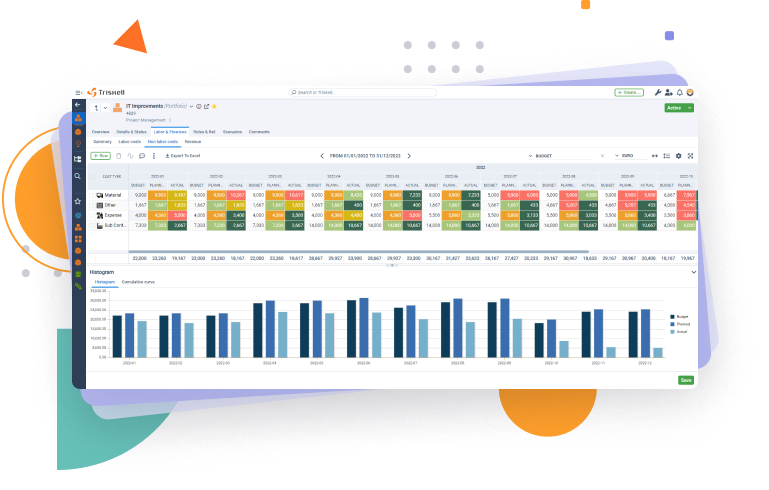
Related Content

ESG principles, frameworks and best practices for Project Management
Align projects with ESG principles. Learn how companies use frameworks like GRI & SASB to meet sustainability goals and improve compliance.

10 types of Project Management Offices (PMO): structure, purpose and how to choose the right one
Learn about different PMO types, their governance levels, and which one is the best fit for your company’s project management needs.

How to create a project budget: methods and techniques for effective project budgeting
Learn how to create a project budget with this detailed guide. Discover essential methods and techniques for effective project budgeting in PPM.
FAQs about Lean Portfolio Management
What challenges might an organization face when transitioning to Lean Portfolio Management?
Transitioning to Lean Portfolio Management can be challenging due to the need for cultural change, the shift from traditional budgeting to Lean budgeting, and the reorganization of existing processes to align with value streams.
Resistance to change, lack of understanding of Lean principles, and the complexity of implementing new governance structures are common hurdles.
However, with proper leadership, training, and the right tools, these challenges can be effectively managed.
Can Lean Portfolio Management be scaled in large enterprises with multiple business units?
Yes, Lean Portfolio Management is scalable and can be effectively implemented in large enterprises with multiple business units. Scaling Lean Portfolio Management requires a well-defined framework that aligns the strategic objectives of various units with the organization’s overall vision.
Tools like PPM (Project Portfolio Management) software are particularly useful in scaling efforts, as they help centralize data, automate processes, and ensure consistent alignment across all levels of the organization.
What role does technology play in the successful implementation of Lean Portfolio Management?
Technology plays a critical role in the successful implementation of Lean Portfolio Management by providing the tools needed for data centralization, process automation, and performance tracking.
PPM software, for example, facilitates the integration of Agile methodologies, real-time resource management, and advanced reporting, which are essential for maintaining agility and maximizing efficiency in Lean Portfolio Management.
The right technology ensures that all processes are aligned, transparent, and scalable across the organization.
